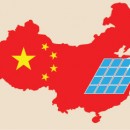2014 Marks the 60th Anniversary of the Modern Solar Cell
- -
Based on previous work completed by Scottish scientist James Clerk Maxwell and British scientists, Professor William Grylls Adams and his student Richard Evans Day, Charles Fritts of New York constructed the world’s first photoelectric module. He spread a wide, thin layer of selenium onto a metal plate and covered it with a thin, semitransparent gold-leaf film. Fritts sent one of his solar panels to Werner von Siemens, a renowned German scientist who in turn presented Fritts’s panel to the Royal Academy of Prussia. Siemens declared to the scientific world that the American’s modules “presented for the first time, the direct conversion of the energy of light into electrical energy.”
In late February 1953, Bell scientist Daryl Chapin received from Gerald Pearson also from Bell the silicon solar cell that Pearson had made. Chapin’s tests, conducted in strong sunlight showed the silicon solar cell had an efficiency of 2.3 percent, about five times greater than the selenium cell.
To this day research continues and the efficiency of solar technology to convert sunlight into energy consistently improves. This drives market acceptance by homeowners looking for cleaner and more secure energy supply.
“Since 2010 solar rooftop installations in the U.S. have increased six-fold. Ninety percent of Germany’s solar is from roof top panels and on June 9, 2014 over 50% of Germany’s electricity demand was met by solar energy” said Marlene Moore, VP Marketing of Green Power Labs Inc. “In Australia 1.4 million homes have solar on roofs and the number is growing dramatically.”
Moore suggested homeowners look first to independent but recent information sources such as Oregon Solar Electric Guide or The Homeowners Guide to Going Solar 2014 or the Complete Idiots Guide to Going Solar (for fee) to inform their buying decision. Moore concluded “homeowners may also want to use our free SolarRatingOnline tool to determine the suitability of their rooftop for solar hot water and electricity systems.














